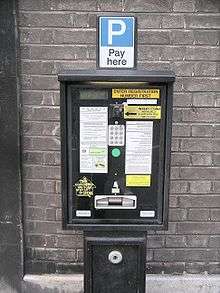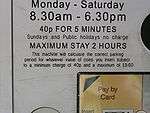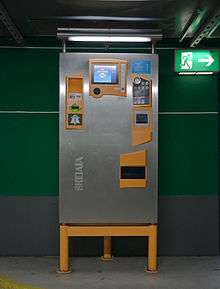Pay and display
A pay and display machine is a type of ticket machine used for regulating parking in urban areas or in car parks. It relies on a customer purchasing a ticket from a machine and displaying the ticket on the dashboard, windscreen or passenger window of the vehicle. Details included on a printed ticket are generally the location and operator of the machine, expiry time, fee paid and time entered.

Systems
The first generation of pay and display machines in the United States was introduced in 1950 by Park-UR-Self, based in San Francisco, California. Park-Ur-Self has grown to become the leading manufacturer of pay and display machines in the United States and now goes by the name Ventek International
Pay and display

Pay and display systems differ from road-side parking meters in that one machine can service multiple vehicle spaces, resulting in lower set up costs. In addition, this system theoretically prevents drivers from taking advantage of parking meters that have time remaining; this factor alone has doubled parking revenues in cities that have switched to pay and display.[1] A driver may occasionally take advantage of remaining time should a departing parker give away a ticket with remaining time. This can be prevented by putting the license plate number on the ticket.

In addition, pay and display machines can also accept a wider variety of coins, and many even accept credit cards, making it unnecessary for drivers to carry large amounts of change. The use of credit cards has another advantage - the machines do not have to be emptied of coins as often, and the costs of counting coin and possible pilfering by employees who empty the parking meters also reduces their overall costs.
In the UK pay and display is used for both on-street parking control and parking in car parks and multi-storey car parks where access barrier systems are not installed.
Pay on foot

Pay on foot is a variant where the driver is issued with a ticket at a barrier upon entering the car park. At the end of their stay the driver inserts the ticket into a machine which calculates the amount based on the duration of stay. The driver then exits the car park by inserting the paid ticket into another barrier. This system means that drivers do not have to decide on their duration in advance.
Higher technology systems
Progressions of pay and display include pay by phone parking and Pay by Plate, where payment is linked to a specific vehicle registration plate.
Coupon parking

Coupon parking is a variation of pay and display without the use of machines; instead, the motorist purchases a booklet of coupons in advance from the authorities. To use a parking coupon, the motorist has to completely tear off tabs of the date and time, or scratch off panels on the date and time in which he/she leaves the vehicle. This process is similar to disc parking, except that a parking disc is reusable whereas a coupon can only be used once. In the Republic of Ireland, reusable free-parking discs are unknown and parking coupons are called "parking discs".[2][3] The coupon is displayed on the dashboard or hung from the top of a door window facing the roadside. Multiple coupons are used if the parking time exceeds the allowance given for a single coupon, though this is not always permitted. The system is widely used in Singapore and Brazil, and in parts of some countries such as New Zealand, Malaysia, Austria, Ireland and Israel.
See also
| Wikimedia Commons has media related to Pay and display. |
- Decriminalised parking enforcement
- Parking guidance and information
- Pay by phone parking
References
- Toronto reaps big profit in parking Archived 2007-08-20 at the Wayback Machine - www.preciseparklink.com
- "You are the Ombudsman! How would you decide?". Information for Schools. Dublin: Office of the Ombudsman. Retrieved 11 April 2011.
- "Parking fines and vehicle clamping". Citizens Information. Dublin: Citizens Information Board. 11 March 2011. Retrieved 11 April 2011.